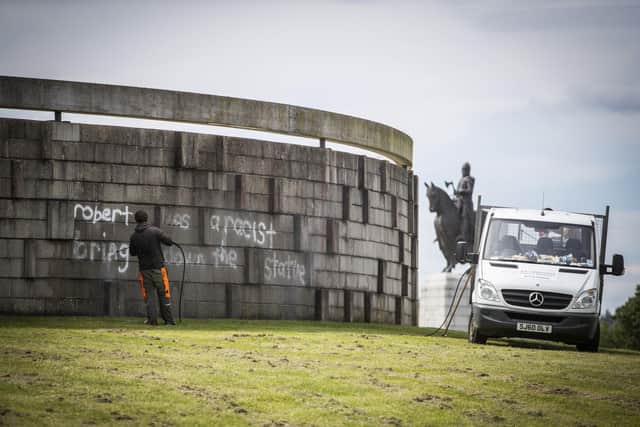Why has Robert the Bruce been branded a racist?


The statue was targeted by anti-racism campaigners who left the words “Robert was a racist bring down the statue” on the monument, alongwith the tag for the Black Lives Matter protest.
But why did the First King of Scots and leader of Scotland’s forces during much of the first Wars of Independence come under such an attack?
Advertisement
Hide AdAdvertisement
Hide AdA statement from the Battle of Bannockburn Experience visitor centre has attempted to illuminate the issues surrounding the vandalism, the racism claims and why Bruce has been portrayed in this way.
While it is was not immediately apparent what the graffiti was referencing, it may relate to the fact that Bruce had his heart taken on a crusade following his death in 1329, the centre said.
The statment added: “Sir James Douglas, who was an experience Scottish war leader and had been personally knighted by the king at the Battle of Bannockburn in 1314, led a company of seven other knights and 20 squires to southern Spain, where they joined the army of King Alfonso XI of Castile on campaign against the Muslim emirate of Granada.
“Douglas and his companions were killed at the Battle of Teba in 1330, fighting troops that would have been predominantly (perhaps exclusively) black.
“Some modern histories have sought to present the Scots’ intention as being a peaceful pilgrimage to the Holy Sepulchre in Jerusalem that was merely diverted to warfare in Spain when passage to the Holy Land proved too difficult to manage.
“However, it is clear from contemporary sources, such as the safe conduct Edward III had produced so that Douglas’s party could pass through England on their way to the Continent in 1329, or the absolution given by the pope for the removal of the king’s heart, that the Scots intention had been to do battle ‘against Saracens’.”
‘Saracens’ was a word used in medieval Christendom as a ‘catch-all term for Muslims’ and was certainly not a term that anyone every applied to themselves, the centre said.
While the religious motivations behind the actions of the Douglas party were obvious, they should not be used to obscure the racial element of the conflict that Scots were involving themselves with, the statement added.
Advertisement
Hide AdAdvertisement
Hide AdIt said: “Medieval discussions of ‘race’ were not as systemised or rigidly structured as they would become in later centuries. But recent scholarship has shown that colour prejudice existed in the medieval period add that the development of the deeply flawed racial discourse that would emerge in the early modern period had already begun.
“The extent to which these broad European trends directly impacted the Scottish political community in general, and King Robert in particular, is limited somewhat by a lack of Scottish sources that discuss the issue.
“However, the Scots were certainly well aware of an engaged with ideas from outwith the kingdom and were thus susceptible to this kind of thinking.”
It was important that black visitors to the Battle of Bannockburn Visitor Centre felt ‘safe and welcome’, the statement continued.
“The Battle of Bannockburn was a hugely significant moment in Scottish history and is part of a heritage that black Scots have as much right to share in as anyone else. We hope that the statue of King Robert stands as a tribute to his achievement in June 1314 and as a representation of the enormous contribution he made in shaping Scotland’s history in the 14th Century and beyond.
“We are commited to promoting public engagement with his remarkable life story, both the positives and the negatives, in an open and inclusive way, as we seek to be responsive to concerns about our efforts to achieve this,” it said.
The centre was “very disappointed” about the vandalism at the Bruce statue at Bannockburn at a time when the National Trust for Scotland, the conservation charity that owns the site, is facing serious financial hardship.
A message from the Editor:Thank you for reading this story on our website. While I have your attention, I also have an important request to make of you.With the coronavirus lockdown having a major impact on many of our advertisers - and consequently the revenue we receive - we are more reliant than ever on you taking out a digital subscription.Subscribe to scotsman.com and enjoy unlimited access to Scottish news and information online and on our app. With a digital subscription, you can read more than 5 articles, see fewer ads, enjoy faster load times, and get access to exclusive newsletters and content. Visit https://www.scotsman.com/subscriptions now to sign up.
Advertisement
Hide AdAdvertisement
Hide AdOur journalism costs money and we rely on advertising, print and digital revenues to help to support them. By supporting us, we are able to support you in providing trusted, fact-checked content for this website.
Joy Yates
Editorial Director